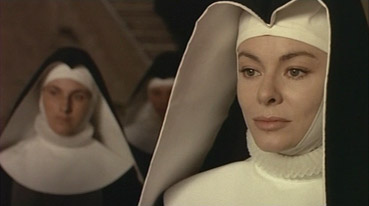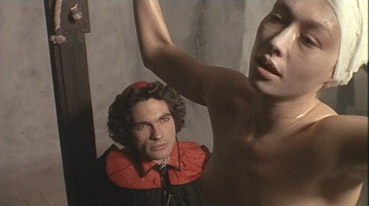|
Seriously,
there can be few fans of cult cinema who would fail to be
intrigued by a 1973 movie with the title The Nun and the
Devil, especially one that features an actress named Maria Cumani
Quasimodo and that is being promoted as "the best of the
sex-and-violence-in-a-convent movies.* I have to admit to being
only dimly aware that such a sub-genre even existed, let
alone familiar enough with an example against which other such films might
be judged. But turn the DVD cover over and there's more.
A quote from the non-culinary Spaghetti Nightmares claims the film is a "ferocious Italian answer to The
Devils with heavy erotic element." Ferocious,
eh? And comparing the film to Ken Russell's still-unreleased-on-DVD
masterpiece is taking a big bloody risk with audience expectations.
The final cake icing takes the shape of a red banner at
the top of the DVD cover that announces this as the "Restored
Full Uncensored Version," hammering the point home
with a triple proclamation of the same thing.
The
suggestion is clearly of a salacious story of sexually frustrated
nuns and what really goes on Behind Convent Walls (which is the title
of the one sex-and-violence-in-a-convent movie, directed
by Walerian Borowczyk, that most cult film fans will have
heard of and perhaps even seen). Certainly the early scenes
point us in that direction, with two ambitious and beautiful
nuns both vying for the position of Mother Superior, and
both with their own sexual secrets – Mother Carmella clandestinely receives
a male lover at night, while Mother Julia Guila has
an eye for the younger novices and is also attempting to
speed up the succession process by treating the present
Mother Superior's illness with poison.

The first thing to note is that if it's racy sex you're
after then you've picked the wrong film. There's
precious little nudity, and what little sex you'll find here is
presented with surprising coyness. Even the lesbian eroticism
on which this release is partly trading is hardly going
to have the Daily Mail campaigning for a ban, though if
legs and knees float your boat then there's one scene that
should certainly have you leaping for the rewind button.
By
the midway point, it becomes clear that this is not an erotic
drama but a drama with mildly erotic asides, a story of
intrigue and power struggles, but one more akin to the shallow
family wrangles of Dallas than the almost
apocalyptic confrontations of The Devils.
Character and narrative depth are largely absent, and a
potentially interesting sub-plot involving wealthy landowners
and their connection with the convent is paid only a passing visit.
Russell's
film nonetheless casts a significant shadow, and following
Mother Julia's appointment as Mother Superior, a series
of anonymous, finger-pointing letters to the church hierarchy
spark off an inquisition that both cinematic tradition and history
itself tells is us not going to go well for the nuns. When
intolerance and questions move on to torture, it's hard
to say for sure if such scenes are staged to horrify or
perversely titillate (and I'm not condemning the film for
either). The Catholic Church is certainly not painted in the friendliest of colours, but given the documented horrors
of the inquisition, the church hierachy are in no position
to complain. Dramatically, this is where the film finds its
feet and we start to care about the nuns and their plight,
an alignment with female victims of male-enforced religious
oppression of a sort that is depressingly still inflicted
in certain corners of the globe.
Time
has rendered The Nun and the Devil a curious
beast, neither as erotic as it must once have seemed nor
that compelling as drama, despite the upturn towards the
end. What does surprise, however, is quality of the production
values, especially the handsome, fluid cinematography (cinematographer
Giuseppe Ruzzolini also shot Pasolini's Oedipus
Rex and Theorum, and Sergio Leone's
A Fistful of Dynamite), which gives the
film a sheen that outclasses much of its content.
Framed
1.78:1, the print here is in surprisingly pleasing shape.
Dust spots are there but thin on the ground, and
the colour and detail are rather good – if this was an
anamorphic transfer it would score some serious points,
but it unfortunately isn't. Occasionally things get a little
dark, notably a night-time murder where it's difficult to
work out just what the hell is going on.

The
mono Dolby 2.0 soundtrack has some background fluff and
hiss and even the occasional clunk, but is otherwise perfectly
serviceable. Although an Italian film, the international
cast appears to have forced the choice of English as the
default language – although there has clearly been some
post-dubbing, for most of the time the lip movements match
the dialogue perfectly.
Not a wimple.
A
not uninteresting film from the early 1970s, restored and
resurrected for investigation by the curious. My own uncertainty
over its merits is far from universal, and there are those
who hold it in very high regard. Argent Films' DVD boasts
a decent (if non-anamorphic) print, but is disappointingly
devoid of extras.
*
From the Aurum Horror Encyclopaedia.
|